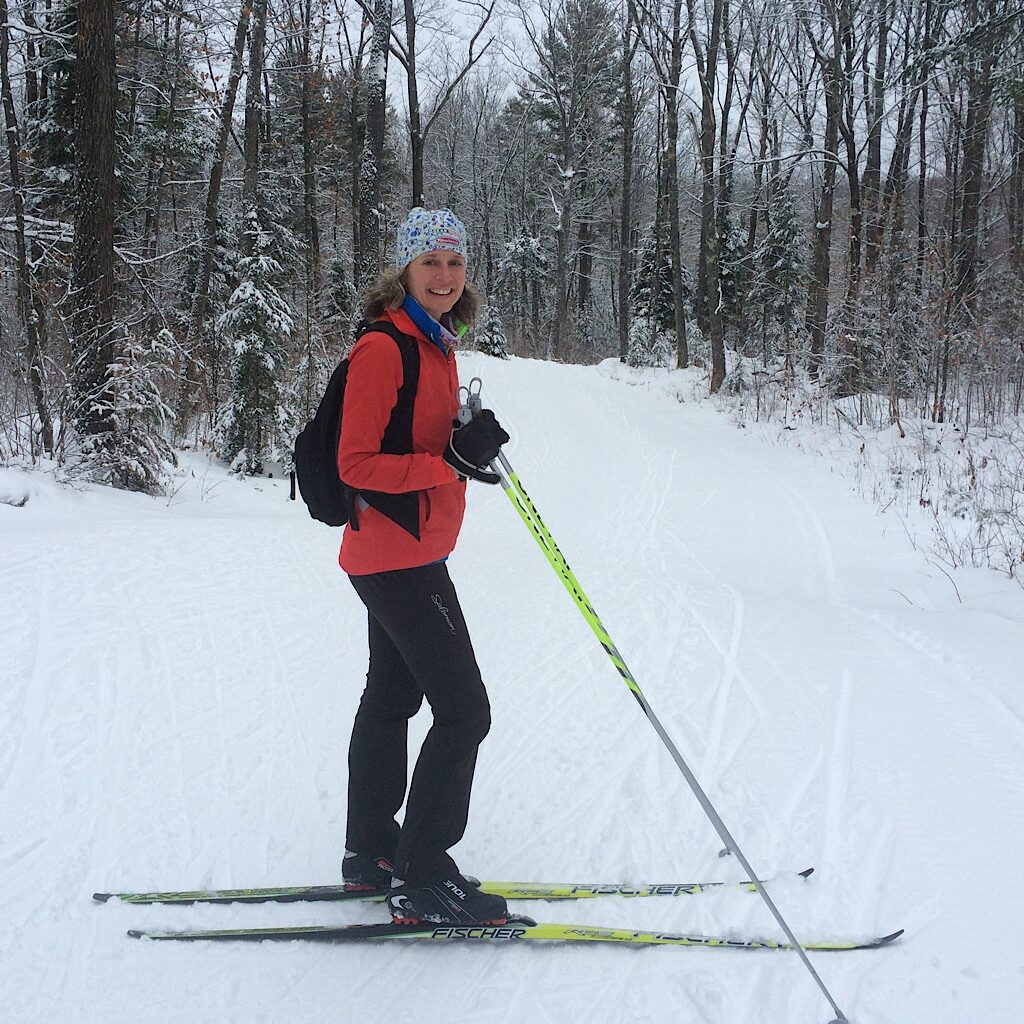
In the beginner’s mind there are many possibilities, but in the expert’s mind there are few.
Shunryu Suzuki
The air is bitterly cold, freezing my nostril hairs. It’s windy too and any exposed skin is at risk, a face mask of little help. So I move fast, clicking my slender black boots into my skis and shoving my giant lobster mitts through complicated wrist straps.
I’m at Giants Ridge in the Iron Range, a good-sized mountain for these parts and a four-season destination for the outdoor enthusiast. Our good friends Debby and Todd live here, spending their winters on ski patrol and as trail groomers, as well as honing their already superb ski technique. It was Debby who first taught me how to ski uphill and encouraged me to race in the American Birkiebeiner – thirty-two miles, up and down through Northern woodland. I took part three times before I gave it up to hike over the winter months the Southern Hemisphere.
That one season turned into two and then three when my hips had to be replaced, at which point I developed a fear of standing atop long, slippery pieces of carbon fiber and sliding on sometimes icy snow. This weekend, though, I plan a return to skiing – or at the very least “pushing through the snow” as I call it – to put those fears to rest.
As it turns out, I’m not capable of either.
The minute I stand up, it’s as if I’d never, ever stood before. How does one gracefully push forward, I wonder as I tentatively slide in the direction my friends are headed. My poles feel huge in my hands. And they are, about a foot and half longer than the walking sticks always at my side over the intervening years.
But it’s not just the unwieldy poles and floppy skis refusing to move that have me stuck in place. My feet hurt. As do my ankles, achilles, calves, quads, shoulders – in fact, everything is screaming, “No!” It isn’t as if I’m out of shape, it’s more like my body has simply forgotten how to move.
I try V1, the “stroke” used for climbing where the poles go down on one side at the same time the foot lunges the ski forward. The idea is that the body is also crunching down as the pole digs in, coiling up before springing up, the arms flung forward and the ski thrusting up.
Up go the arms and down I fall.
Undignified has become my my middle name. I roll around for a few moments, my butt high in the air trying to figure out how to get back on top of these awkward sticks, slippery and sticky all at the same time. I lay down on my stomach, but the tips just dig into the cold snow. I roll on my side, but can’t get purchase with my poles. Sitting up is no better. Oh hell, just take them off and stand up.
Off they go and of course, I’m up easily. That I can do. I reluctantly click my boots back into place as my friends disappear up a small hill. All I can do is a crunchy herringbone in the frozen corduroy of freshly groomed track. When I reach them, I begin to sob.
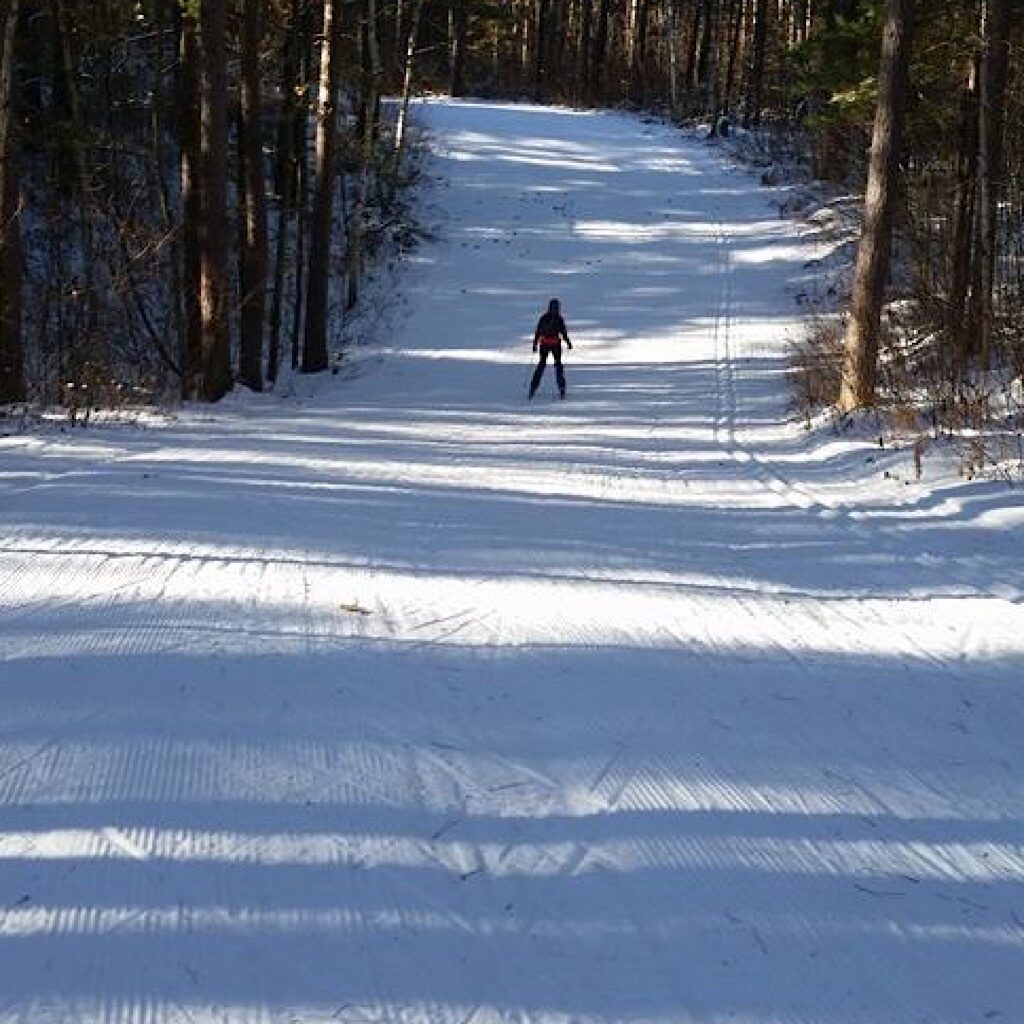
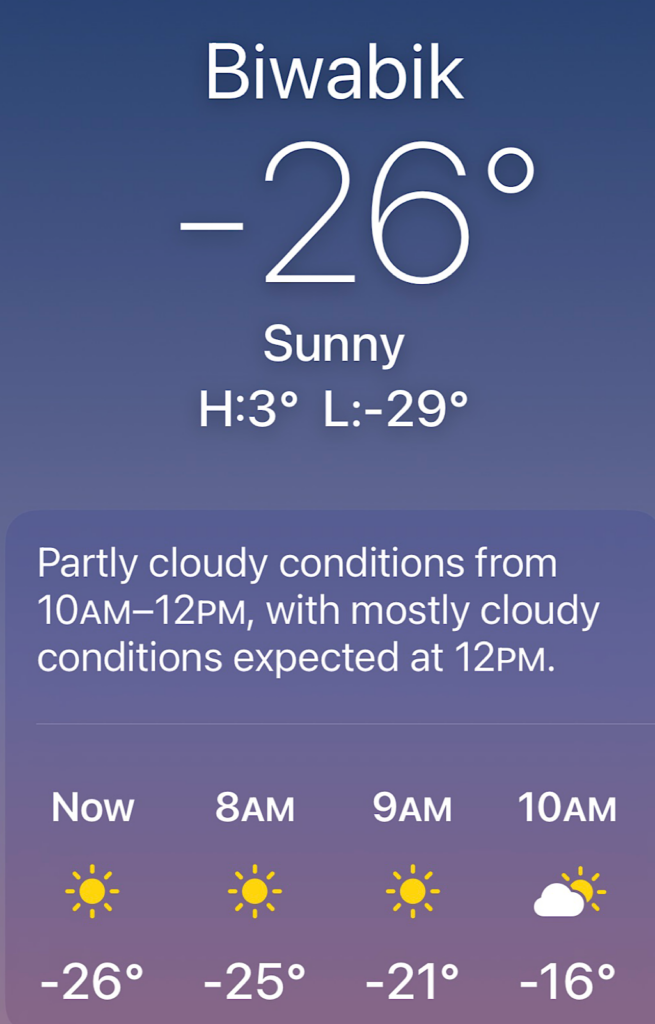
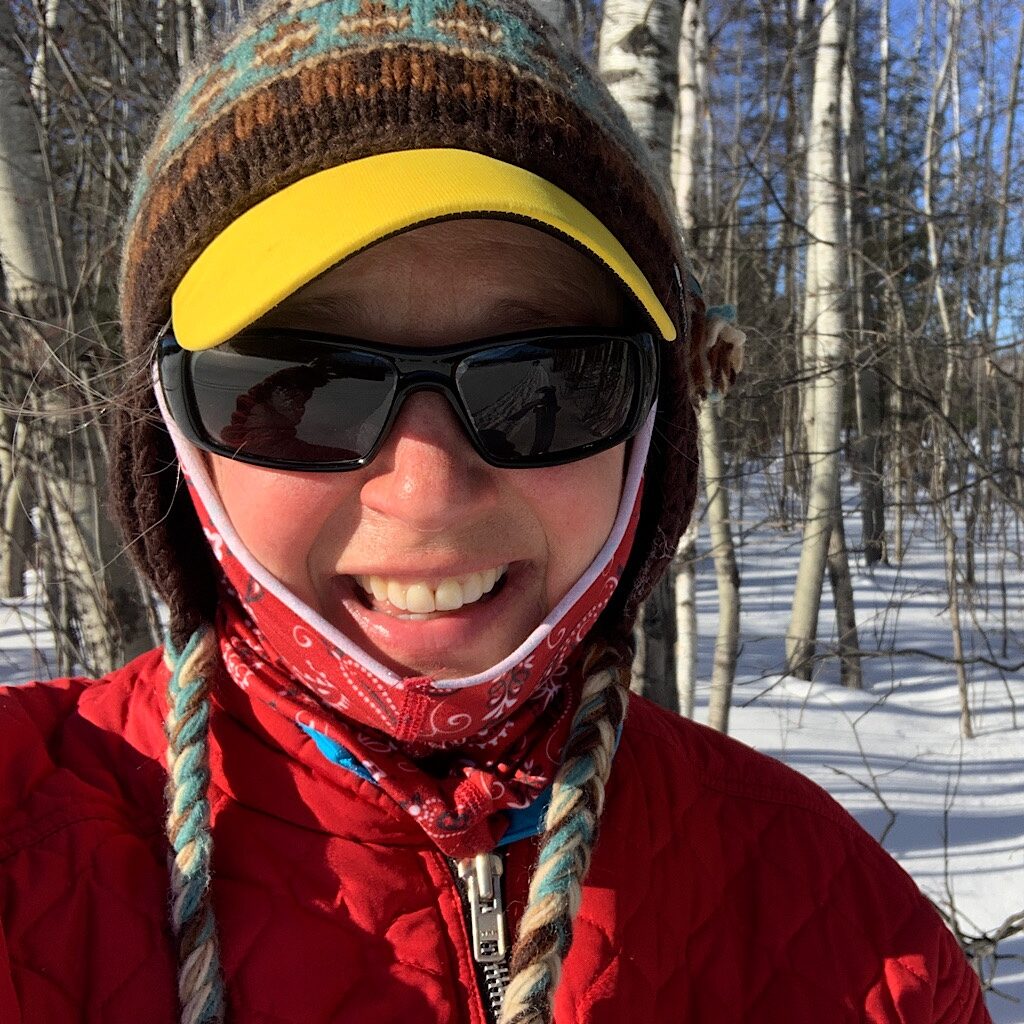
The day actually starts out a lot more hopeful. The three of us, along with Richard, begin on snow shoes, walking through a wonderland of forest and wetland. The sky is a deep blue and the snow sparkles like so many diamonds. This part of the north woods is right at the edge of the boreal forests, and is filled with white and red pine, spruce and cedar as well as deciduous trees like maple, ash and basswood. Most prominent here, though, are paper birches, peeling away in pink scrolls. Big, fluffy snowballs weight down fanning branches or sit atop stumps chronicling heavy snowfall from a few days ago.
Today is clear, dry and cold as we tramp on an expertly groomed fat-bike track trail, hard-packed and making snow shoes unnecessary. It’s shared with a wolf pack that left telltale signs including blood-stained fur clumps and scat. Wynne Creek widens below us into a wetland of graying tree trunks and exploded cattails. From here, the downhill ski slopes loom like a cake dripping in vanilla frosting.
I’m enjoying the walk, but it feels easy and slow. Did I say something to indicate my mood or did Todd just sense my impatience and need to get moving? When we cross the ski track, he points to another portion of bike trail that’s not been groomed or “rolled.”
“It goes uphill – for a long way,” he tells me.
“Shall I lead?”
The answer comes by way of his moving aside to let me pass. I bound up into two feet of fresh snow like a dog off its lead. Oh, I feel so awake and alive plowing through, stepping big and strong, glad I brought walking sticks with little baskets on the end for balance.
I hear them behind me as the path winds around, then lose them crossing the ski trail again and finding another un-groomed bit heading down steeply. Days like this bring such joy. Crisp, bright, and finally warm now that I’m moving fast. I’m far ahead now, and call out, but get no answer. Snowshoeing is loud and I trust we’ll all come together again at the chalet.
We do, and take a little lunch and a little rest before suiting up for an afternoon of skiing. But now, the weather has changed, clouding up as the temperature rises just above 0. The gray dampens my spirits and intensifies my nervousness of putting on skis in the presence of experts. I may walk strong and be willing to cut trail in deep snow, but I’m legs-akimbo when it comes to skiing.
And things do not go well. Minnesotan to the bone, Debby and Todd ignore my distress and just keep moving forward. At one point, Debby throws out a tip as if coaching for life, “Don’t look at your feet, look where you want to go!”
I would if I could.
But it’s no use if you can’t glide. Truth is, temperatures this cold make skate – or “freestyle” – skiing, if not impossible, very difficult. That’s because skating is more like, well, skating, where the skis are pushed out to the side in lateral movements that are both unnatural and exhausting. It’s tough, some considering it the hardest outdoor sport there is. It requires a unique combination of strength, speed, and endurance plus a wide and specially groomed track and its own set of skis, which have their own requirements of regular waxing depending on the temperature and type of snow one plans to ski on. Needless-to-say, there is an entire art to skate skiing that can take years to master.
I received my first pair of cross country skis when I was in high school. They were not skate skis, but “classic” or Nordic skis with fish scales on the bottom. I never once waxed them for speed. That’s because I used them more like an extension of my feet, ski-walking through the forests around Interlochen, Michigan at night to take a break from an intense schedule of flute practice and academics. I loved those days even if they weren’t particularly athletic. On one of pristine night alone in the middle of a frozen lake, I saw my first Aurora Borealis.
Decades passed before we moved to Minnesota. In the first winter knowing I had to do something to manage the extreme cold, I took out those same skis and pushed around a local golf course. I still remember the first time I saw someone fly past me throwing their legs out to the side and making giant V’s in the snow rather than forward like a walker. It looked so graceful, effortless and badass, I was determined to learn how to do it myself.
Things were easier for me before new hips, that’s for sure, but I tended to look less bad ass and more eggbeater most of my skiing career, muscling up hills rather than improving my technique. I skated an entire half-Birkie marathon, the Korteloppet, before realizing there were other, less tiring strokes than V1 mile after mile.
It would require nearly daily practice on the other side of town at a ski hill covered in manmade snow to finally see improvement, plus lots of visits to friends who lived up north close to expert trails. This afternoon, mid-sob, Debby tells me, “This place isn’t really set up for beginners!” and she’s right as there’s not much by way of a “kiddie pool” on trails that head straight up, then straight down like roller coasters, veering sharply just as you pick up speed.
This may be no country for old beginners, but it is one for kind and perceptive friends. As I blubber away feeling constricted and unable to move, Todd tells me he just happened to pack an extra pair of freshly waxed “classic” skis in the trunk of his Subaru.
Fortunately my boots fit most bindings and I am able to slip on his skis. Both skis and poles are shorter and instantly feel more natural and straightforward like walking. No offense to professional skiers, but to move forward on classic skis, albeit slowly, requires very little skill. And that’s patently obvious as I quickly cruise up in the deep track, jump-walking or stepping out to herringbone. My tears freeze on my lashes and I trade sniffling for heavy breathing since any form of cross-country skiing is a workout. I’m feeling stronger and, more important, happier.
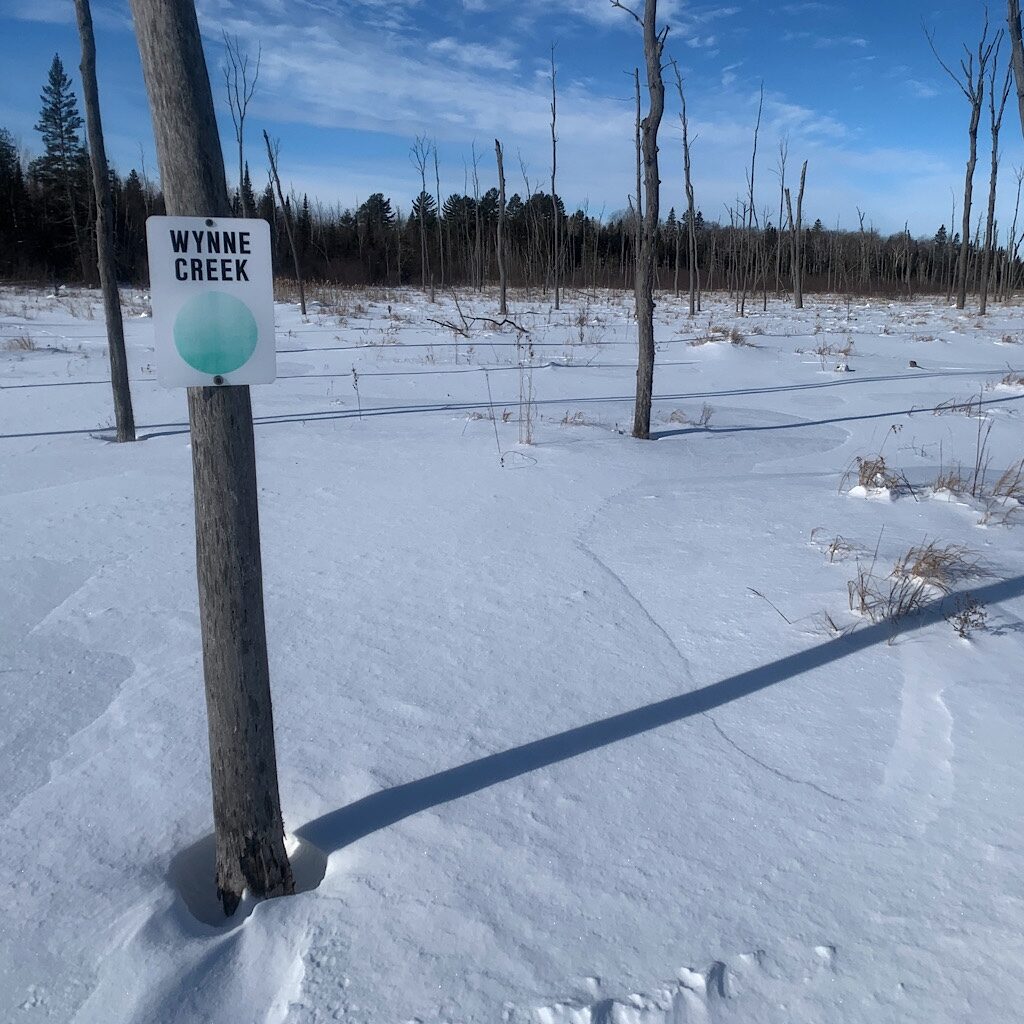
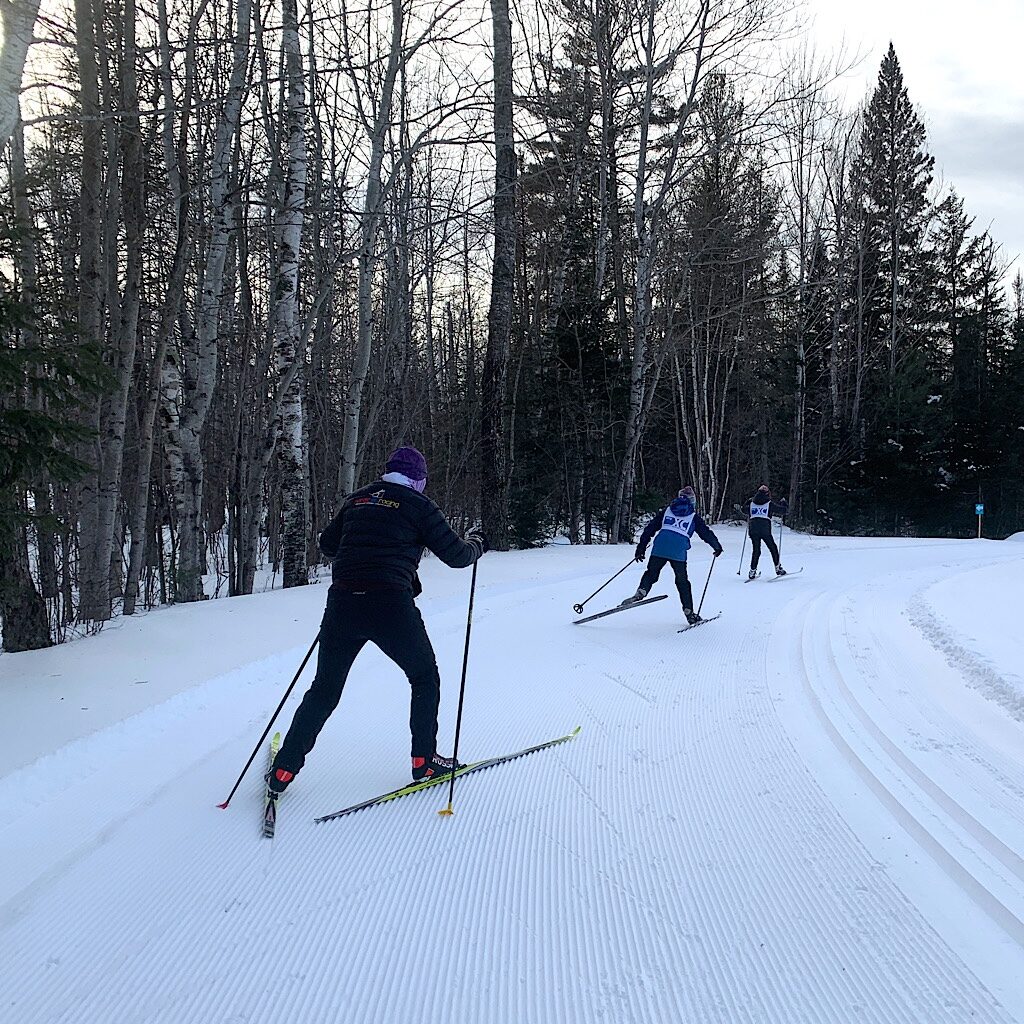
As the sun slowly slips towards the horizon, Debby offers up more expert advice, “They do say you should start first with Nordic, then transition to skate.” Well OK, then, I’m going to go out again first thing tomorrow.
And I do just that, borrowing Todd’s skis while they head to church to give this whole thing another try. Again the sky is a deep blue, the temperature even lower with frigid air tightening my lungs. My poles cut into the snow with a rhythmic ke-sploink! as I push deeper into the rolling part of the forest close to where we snowshoed the previous day. I pass my favorite places – the perch high above wetlands where the cattails explode in fuzz, a row of birches, their crispy white bark curling into scrolls that flap in the gentle breeze, bloody fur next to wolf scat in the middle of the trail, deep footprints up a cutoff where yesterday’s adventure began, and the ridges of icy snow where I started crying in frustration. No one is out and I wonder for a moment if it’s safe to be alone, but I know I need this time to remind myself what it feels like to move forward surrounded by subtle beauty.
I realize that it’s not all about the joy of progressing. Being out here is also a bit of a test, one I’m deeply aware of as I hop up a hill, then snowplow back down, willing myself to stay upright as I bend and lean into the curves. I’m testing my legs without anyone watching and reminding myself that it’s OK to not be good at something. In fact, it requires bravery to not be good at something and still keep trying.
I pass through the wetlands and take a picture of my shadow, dark blue on glittery white. I’m ready now to head back and change into my skate skis. Debby has a class this afternoon with two grade school boys and will go over some of the fundamentals of skate skiing, fundamentals I tended to ignore.
We introduce ourselves, Cabe in 7th grade and Kim in 6th, then me in 20th grade. It takes them a second or two before they realize I’m joking and then we’re off, skiing without poles around cones, trying to lean out, our body all the way up to our nose reaching across each ski. We then take our poles for the V2, a kind of double-poling waltz that really makes you fly. We then follow the leader and click our heels, trying to bring our skis closer together.
Of course I overcompensate, toppling over in a heap. I get up in time for them to come around again, Kim asking me where I’ve been all this time before flopping down in the snow himself. Eventually they head on and I pull back to practice on my own. Gliiiide-pole-gliiiide-pole-gliiide-pole, pole-up-pole-up-pole-up, shush-shush-shush and then a little rest, just me, my breath and the beautiful forest.
Why on earth did I cry so much yesterday, I wonder. I’m sure I was frightened that I’d lost my skills. It reminded me of developing dystonia, feeling as if a kind of dementia had robbed me of all that freedom of movement. But this is not dystonia. I can move on skis, I just haven’t done it in a long time.
And there’s another piece to this. Not being able to move well this time around is not a case of losing something that has to be mourned. Rather it’s reminder that sometimes we need to a little humility and a willingness to suck at something for a while. For someone with perfectionist tendencies, that’s a whole lot harder than letting go entirely, because I tend to slip into excuse-making and denial rather than face my limitations and salvage what can be done. I find, if I’m willing to accept that there’s nothing to prove and yet so much to gain by trying – even when I suck – the entire exercise becomes less a challenge to overcome and more like playing and having fun. Even Debby stated the obvious yesterday as I cried, “If you want to ski, you will.”
Richard and Todd shuffle by me, moving well on classic skis and smiling at my 100% improvement. True that. I went from not being able to move at all to moving somewhat. I follow slowly behind, my muscles tired from the new movements and my lungs burning from the frigid cold air. Debby catches me up and is so slowed down by my pace, she can chatter on, talking about all her amazing women friends, athletes who are still going strong into their 80’s, traveling the world and winning competitions. I’m not really in the mood, focused instead on my tiny victory. I tell her I’d prefer she build me up.
“But Alison, you’re an amazing lady too.”
I am? Well, OK, I guess maybe in this small way of single-minded persistence in learning to ski uphill, I am, too, a little bit amazing.

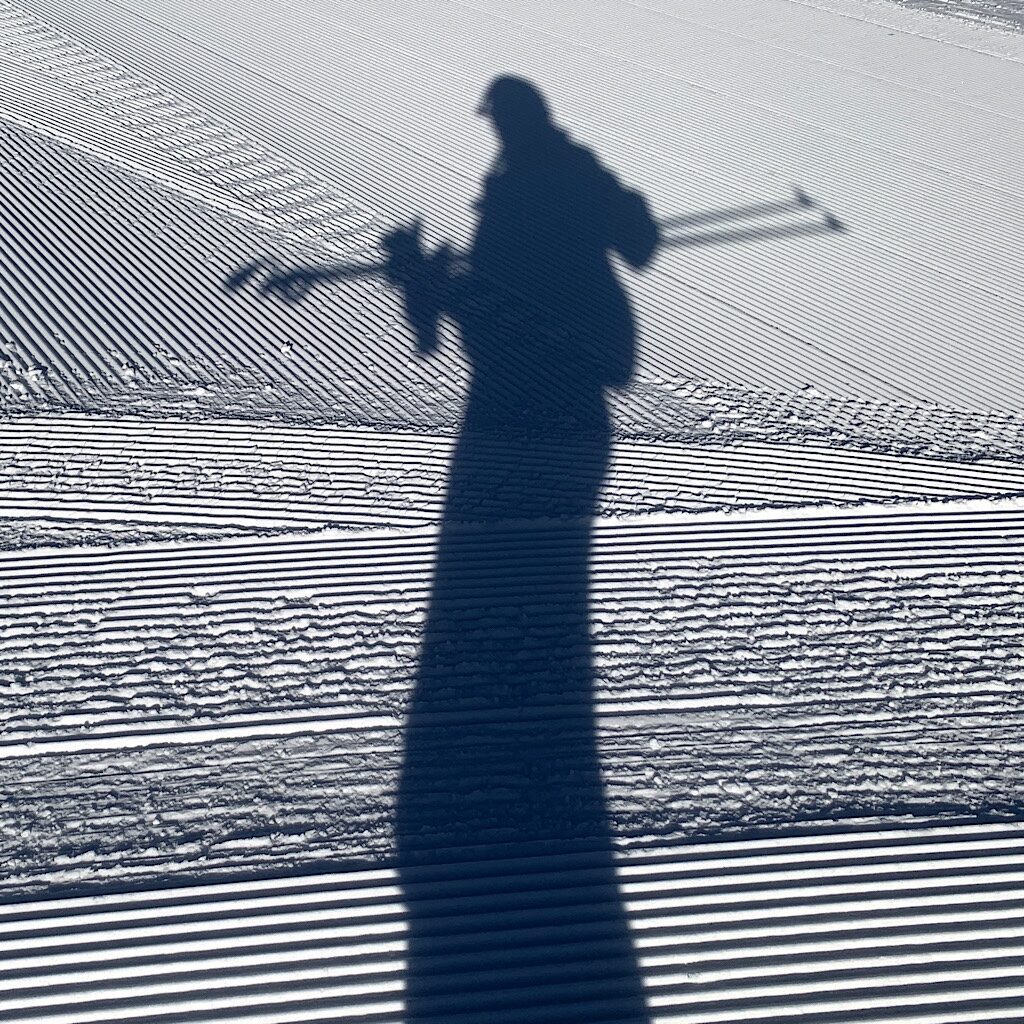
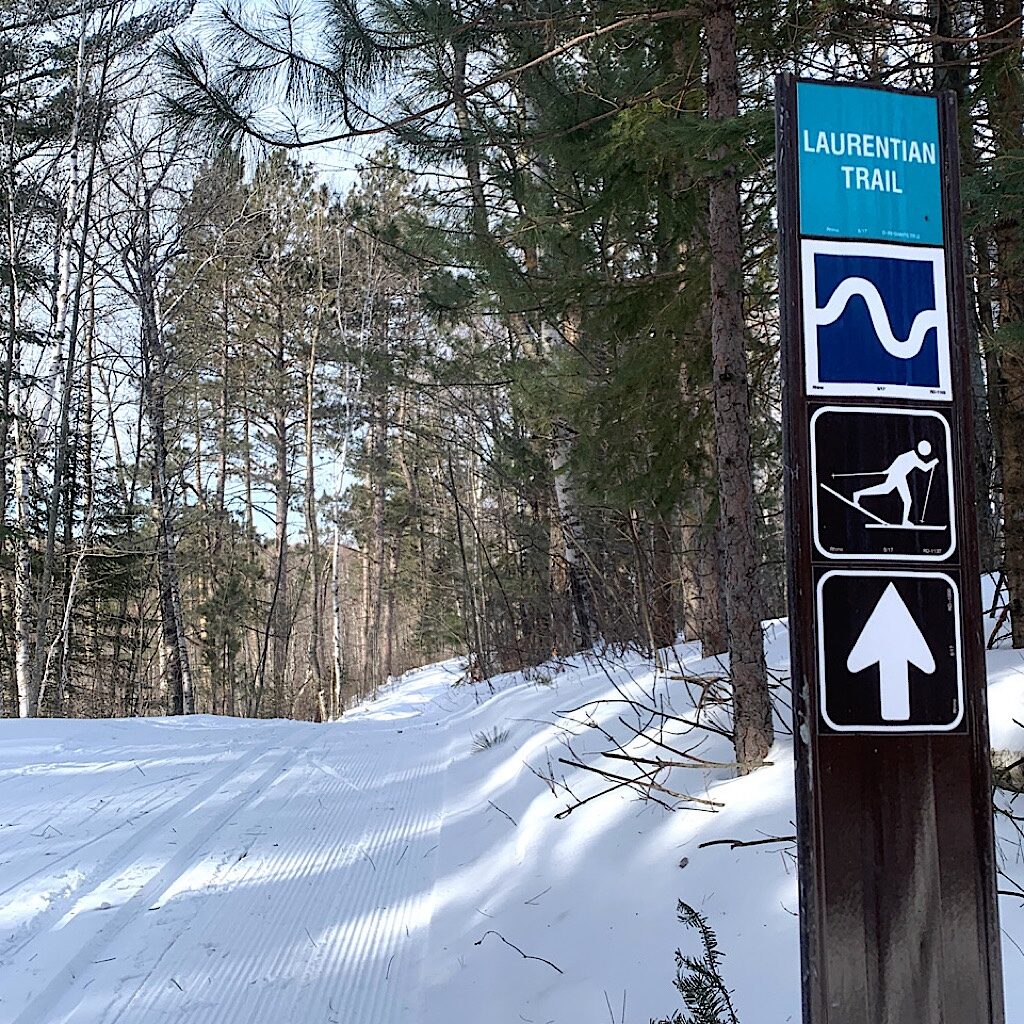


6 Responses
Somehow hiking the world on titanium hip joints seems to pair nicely with your instrument, the flute, still occasionally played with the purpose of sending notes to the heavens. Keep on keeping on, Alison! https://sundaybaroque.org/beautiful-music-in-difficult-times-january-27-2022/
all I need now is a titanium flute! …and I grew up listening to Jethro Tull, too.
thanks Mark!!
I can sympathize! I remember the first time I skied when it was -36! Unfortunately we were trying out different types of skis before purchasing and that weekend we rented fish scale skis. Perfect for slush but glue for below zero temps. I never worked so hard trying to glide and was drenched in sweat despite the cold. I also was not a down hill skier so froze in fear at the top of any incline. If there was a turn at the bottom then I turned or braked by falling. I also started skiing in unbroken snow (no trails) on the north shore. Eventually with flatter surfaces it became more fun than work but I still preferred snowshoes which allowed me to be stable and also take winter photographs. Think of what you are doing as cross training. You will be in even better shape for hiking.
oh, I love this, Jennine! That’s exactly right – I am cross-training the heck out of my body and using muscles I’ll need for climbing over (and under) blowdowns, picking my way through scree and snow and crossing swollen rivers. I like skiing, but agree that snowshoeing allows for more time to take pictures and hear the sounds. Glad you made it down those hills! Ice can make them treacherous and I fortunately took my skis off one bad hill during the Birkie where someone else did not and busted a leg!
Alison…so glad you made it! I don’t like those wolf tracks and your crying…they sense weakness…
But, you do soldier on….catch you on your next blog!
not enough meat on the bones to be too worried 🤣